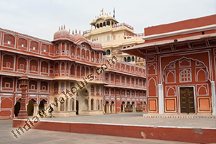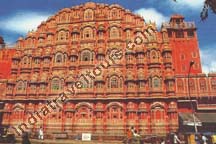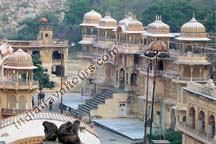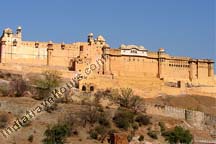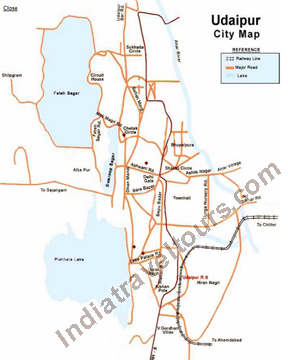|
Some Major Attractions in Jaipur The popular Pink City of India, viz., the capital city Jaipur of Rajasthan in the desert state of India, remains a perennial attraction among the tourists. Its abiding appeal lies in its gorgeous monuments, reflecting the grandeur of a bygone era, the layout of this well planned city itself, its architectural style, its crafts and culture, and the elegance of its people. Here is an attempt to list out some major attractions of this tantalizing city. Many of these attractions can also be covered in a Walking Tour of the city, while the popular hot air balloon safari affords a beautiful bird’s eye view of the city and its environs, besides some of these attractions from above.
The City Palace, Jaipur
The City Palace, Jaipur was the seat of the erstwhile Maharaja of Jaipur, the head of Kachhwaha Rajput Clan of Rajasthan. This palace complex comprises of the Chandra Mahal and the Mubarak Mahal. Apart from serving as the royal quarters, a section of the Chandra Mahal has now been converted as a museum. The construction of this palace was taken up by Sawai Jai Singh, the founder of Jaipur in 1729, which continued upto 1732. The king was himself a keen enthusiast of Indian architectural principles and he was supported in his efforts by his adviser Vidyadhar Bhattacharya. Together, they were instrumental in devising the layout of this palace and the city, and produced an eclectic blend of the codes of Vastu Shastra, with the Rajput and Mughal styles of architecture. This complex displaying palatial buildings, gardens, and courtyards is located in the Old City and is open for visitors during 9.30 AM to 5.00 PM daily. Its Peacock Gate is delicately carved to the last detail.
The Hawa Mahal or the Palace of the Breeze is a unique palace built in 1799 AD by Maharaja Sawai Pratap Singh. It was conceived as the Crown of Krishna. Its five storey front resembles a honeycomb with 953 jharokhas (small windows), which are adorned with intricate latticework. The main purpose of this architectural wonder was to let royal ladies witness the daily life on the streets below, without being watched. Built in pink and red sandstone, this edifice is located right in the middle of the main street in Jaipur’s commercial area. It forms part of Jaipur’s City Palace. It was earlier famous for the constant flow of cool breeze in its interiors, but now with a change in ecological conditions, the inner chambers are no more that airy. This palace provides a glorious view of the sunrise.
The capital city of Jaipur is known for various temples and shrines, which are located in and around this city. One of these temples is Galta ji, which happens to be an ancient shrine dating back to 1500s. It is believed that one prominent Rishi Galav practiced meditation for a long time at this site and ultimately got Moksha. The ruins include a temple dedicated to Balaji and to the Sun God. It is believed that the complex was constructed by Dewan Rao Kriparam, a noble in the court of Sawai Jai Singh during 18th century. The temple complex is known for its natural springs, where the water is collected in seven tanks (kunds). Devout Hindus congregate at this site for a dip in sacred waters during Makar Sankranti. Due to its remoteness and constant availability of water, there is a big congregation of monkeys at this site, thus imparting an image as a Monkey Shrine.
The Amer Fort, pronounced as Amber Fort is located in Amer. Being one of the major attractions in this region, this fort was built by Raja Man Singh on a hill top 11 kms away from Jaipur. Before founding of Jaipur, this fort served as the seat of Kachhwaha Rajput Clan. This monument is famous for its highly sophisticated architectural Style, through fusion of Rajput and Mughal Architecture. The red sandstone and marble structure fronts onto the Maota Lake. The mirror work inside this palace is a pleasure to observe, as also the various halls, walls, and courtyards. The Diwan-e-Aam, Diwan-e-Khas, and Sheesh Mahal are the major tourist attractions, while the Jai Mandir and Sukh Niwas engender a sense of wonder because of their cool environs, despite a raging summer outside. |
|
|
|
|
Informative Travels
162 b, Mayur Vihar, Phase 1, Pocket 1, New Delhi - India. Ph: +91 11 65365544,22758788 Fax: +91 11 22759867 24hrs. Helpline: +91 9350 162 414, 92 1212 7771 For information/Bookings: indiatraveltours@gmail.com / Info@indiatraveltours.com |
| © Copyright Informative Travels 2001-2012. All rights reserved |
